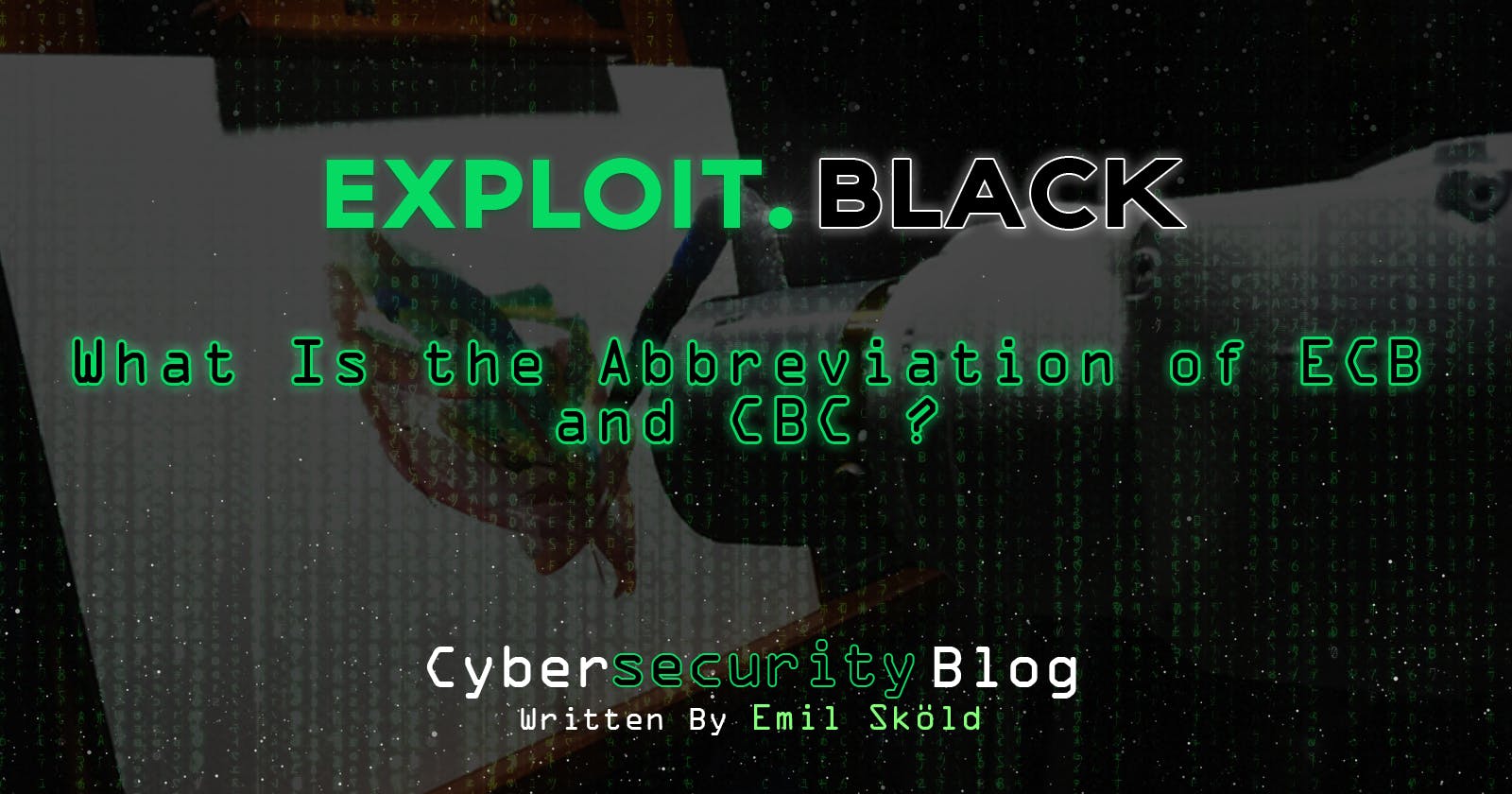
ECB versus CBC Mode AES encryption
The Advanced Encryption Standard (AES) is a block cipher designated as a standard for military and government usage by the United States government.
The Electronic Codebook (ECB) is essentially the first generation of the Advanced Encryption Standard (AES). This is the simplest type of block cipher encryption.
CBC (Cipher Blocker Chaining) is a sophisticated block cipher encryption algorithm. With CBC mode encryption, each ciphertext block is dependent on all plaintext blocks that have been processed thus far. This increases the complexity of the encrypted data.
What Is the Abbreviation of ECB and CBC ?
ECB vs. CBC: Pros and Cons of These Block Cipher Modes. Block ciphers are designed to encrypt a single fixed-size chunk of data. By agreeing on a block cipher mode of operation, the sender and recipient ensure that they do things the same way.
ECB mode leaks data about the underlying message being encrypted. Each block of the plaintext is encrypted completely independently, and decryption can be parallelized.
CBC mode eliminates this problem by carrying information from the encryption or decryption of one block to the next.
The Pros and Cons of ECB and CBC Block Cipher Modes
Block cipher modes of operation are intended to enable the encryption of data that is too lengthy to fit within a single block. While a variety of block ciphers exist, this article examines the advantages and disadvantages of the ECB and CBC modes of operation.
Several distinct types of cryptographic algorithms exist. The most significant disparity exists between symmetric and asymmetric cryptography. Symmetric encryption use the same secret key for encryption and decryption, whereas asymmetric cryptography (also known as public key cryptography) employs a pair of linked public and private keys.
In the category of symmetric encryption are block and stream ciphers. Stream ciphers generate a stream of bits that are exclusive-ored with the plaintext to make the ciphertext, whereas block ciphers encrypt data in blocks of a set size.
Block ciphers are designed to encrypt a single, fixed-size block of data, which causes problems for plaintexts that are not the exact length. Padding assists in resolving the issue of plaintexts that are too small, whereas block cipher modes of operation manage plaintexts that span numerous blocks.
The mode of operation of a block cipher specifies how the various blocks of a multi-block plaintext should be encrypted and decrypted. By agreeing on a block cipher mode of operation (such as ECB or CBC mode), the sender and recipient of a message ensure that they decrypt the data correctly and in the same manner.
ECB mode is the simplest method of operation for block ciphers. It approaches multi-block plaintexts by treating each plaintext block separately.
The graphic above demonstrates how ECB mode operates. Note that the encryption and decryption of a single block has no influence on the encryption and decryption of any other blocks. ECB is the easiest block cipher mode of operation to implement, although it is not without flaws.
The image above depicts the ciphertext produced by the ECB mode encryption of Tux, the Linux penguin. Observe that the penguin is still discernible despite the color distortion.
This occurs because, in ECB mode, encrypting identical plaintext blocks results in identical ciphertext blocks. In this instance, each pixel is a separate block of plaintext containing the pixel's color. Since many of the pixels in this image have the same color, these similar blocks produce identical ciphertext blocks. Tux is therefore still discernible in the ciphertext.
This extreme case illustrates the limitations of the ECB method for data encryption. ECB mode is faster, simpler, and more parallelizable to build, but it loses information about the encrypted message. By only watching the ciphertexts (which are public knowledge), an eavesdropper is able to detect identical blocks and deduce the original plaintext.
The challenges with ECB mode stem from the fact that each plaintext block is encrypted fully separately. CBC mode avoids this issue by transporting encrypted or decrypted information from one block to the next.
The graphic above demonstrates how CBC mode operates. An IV is generated for the initial block's encryption. This IV should be a value that cannot be predicted and is freely communicated to the recipient. It is not hidden.
Before submitting the plaintext to the encryption process, this IV is XORed with it. The resultant ciphertext is then utilized to transport data to the next block's encryption, and so on.
This relationship helps prevent identical plaintext blocks from yielding similar ciphertext blocks. because each blockXO is the plaintext Red with a distinct IV prior to encryption generates a distinct ciphertext. This means that an adversary examining the string of ciphertexts cannot deduce anything from the fact that two identical ciphertext blocks exist.
Although encryption must be conducted sequentially in CBC mode, decryption can be performed in parallel. The initial IV is a public value, and all subsequent IVs are ciphertexts that are also public. This can make decryption faster than other modes of operation for block ciphers.
ECB and CBC are two of several distinct modes of operation for block ciphers. Each of these modes has its own advantages and disadvantages, and the one chosen will depend on the requirements of the project. ECB and CBC modes, for instance, give confidentiality, but Galois Counter Mode (GCM) provides both confidentiality and integrity protection.
Between ECB and CBC mode, CBC mode is always the superior option. As stated previously, ECB mode exposes plaintext information because identical plaintext blocks generate identical ciphertext blocks. ECB mode is insecure and should never be utilized, as ciphertexts should never reveal information about the plaintext used to construct them.
Due to its ease of construction and availability for parallelized decryption, CBC mode is one of the most often used block cipher modes of operation. However, proper implementation of CBC mode is required while employing it. Incorrectly implemented padding of ciphertexts can make a system susceptible to attacks such as POODLE.
While CBC is superior to ECB, GCM is superior to both. In addition to offering strong confidentiality protections without the known security flaws of ECB and CBC mode, it safeguards the data's integrity by creating a message authentication code (MAC) as part of the encryption method.
For this reason, the Ubiq platform operates using the GCM block cipher mode. Consult the Ubiq cryptography libraries for further information about seamlessly incorporating strong cryptography into your applications.
Modes
Other modes exist to address particular scenarios, such as:
The essential takeaway is that each modality offers a variety of advantages and implementation difficulties that must be carefully assessed (and correctly implemented). Whenever possible, avoid the ECB.
Extensive description of how ECB resident features propagate into ciphertext
I tried not to provide an image of a typical ECB-encrypted Linux penguin in this response, but I've been asked to elaborate on "resident attributes in the plaintext," so what follows is the same concept, but in text form. If you do not require it, you may skip it.
First, let's choose a format that I am familiar with: the mp3 frame. As with the vast majority of plaintext, this is not "indistinguishable from random"; for instance, the MP3 frame header begins with 11 bits set to 1.
There are two crucial characteristics of block ciphers:
These claims are applicable only when a single block is considered; but, in the actual world, we need to encrypt many blocks.
Suppose we live in a made-up world where people believe that one-byte block ciphers are a good idea. Now let's assume this block cipher is otherwise flawless. Imagine you have some Justin Bieber MP3s and you would prefer that the NSA did not discover this. Therefore, using your block cipher, you encrypt your MP3.
Now, assuming some file alignment assumptions, one of these blocks will be 0xFF - that's eight of your eleven ones from the frame header in the MP3 file. These are always present at the start of every frame. Now that our encryption cannot be distinguished from randomness, we have perfectly random ciphertext, for example 0x1c. However, it is also deterministic because we employ ECB, so every frame header that was 0xFF becomes 0x1c.
Suddenly, we are divulging information to our attacker, notably the location of the frame headers if they assume this is an MP3. In cryptoanalysis, it is sometimes necessary to make accurate guesses; in this example, a good prediction would give them a sense of how lengthy the audio samples are and allow them to identify the format.
Additionally, every other ciphertext block 0x1c can now be decoded. We did not plan to divulge this information, but we did.
This is a typical issue, especially considering that much of what we encrypt has a strict data format. You must make assumptions regarding the alignment of the blocks, but the larger the dataset, the more evident this issue becomes.
This is what I refer to when I say that residual plaintext qualities become apparent in the ciphertext. These are the structures inherent to and desired in the plaintext that have been disclosed to the attacker inadvertently.
The initial goal of CBC mode was to identify corrupt messages, and this article addresses the security of CBC for this purpose. You may be able to find the original paper implementation of this concept, which I am unable to locate. Certainly, the majority of block ciphers books I've read discuss this issue along with others.
ECB and CBC solely pertain to encryption. Most cases requiring encryption also require integrity checks at some point (ignoring the threat of active attackers is a common mistake). There are combined modes that do encryption and integrity at the same time; see EAX and GCM (see also OCB, but it has some residual patent difficulties; assuming that software patents apply to your circumstance — a naive assumption).on-trivial query — there are then clear licenses).
Never use ECB! It is unsafe.
I advocate using a method of authenticated encryption, such as EAX or GCM. Employ CBC or CTR mode encryption if you cannot use authenticated encryption, and then apply a MAC (such as AES-CMAC or SHA1-HMAC) to the resulting ciphertext.
The ECB is not secure, as information is leaked. CBC is better. Use CTR mode if you need random access to your file.
The phrase "better" is subjective. However, when choosing between ECB and CBC, CBC should be selected in almost all instances.
Although ECB and CBC are modes of operation of a block cipher, the block cipher may also be viewed as a configuration option for the mode of operation. The mode of operation has a significant impact on the cipher's security.
The issue with the ECB is that it is not a functioning mode. It is essentially equivalent to breaking the plaintext into blocks and encrypting them independently of one another. When a block cipher is deemed safe, the ciphertext of a single block, when independently examined, is of course similarly secure. However, ECB is not secure when many messages or messages are encrypted; identical plaintext blocks result in identical ciphertext. This indicates that an adversary can readily detect repetition.
CBC addresses this issue by introducing a vector that modifies the first plaintext block prior to encryption. The result is that the entire ciphertext is randomized, as each block's ciphertext is used as the vector for the subsequent block (and so forth). In other words, it assures that each block is encrypted uniquely, even if it includes identical data.
In addition to being distinct, the IV must be unpredictable to the attacker. This is done to prevent an attacker from altering the plaintext and IV combination: finding a duplicate ciphertext would show that the input to the block cipher has been seen previously, hence revealing the plaintext. Typically, an unpredictable IV is generated using a trustworthy random number generator (RNG or RBG). As encryption and decryption must be done using the same IV, the IV is typically prepended to the ciphertext. A random IV does not require confidentiality.
Is ECB still valuable? Essentially, it should not be utilized to ensure communication privacy. However, it can still be used to encrypt completely random data (such as symmetric keys) or as a building piece for more efficient algorithms and protocols. Consequently, it is still available in nearly all cryptographic APIs.
Note that there are numerous different operational modes besides ECB and CBC. Neither ECB nor CBC give authentication or integrity. This indicates that even CBC is ineffective without extra protection for transport methods. If padding oracle attacks are conceivable, anyone can change messages, and confidentiality may also be compromised.
To cut a long tale short, if there is an abundance of repetitive data, avoid using ECB because the pattern will be clear. Each block in CBC is a cipher for the next block, which makes the algorithm more cumbersome to implement but far more secure.
Never use ECB! It is unsafe.
References:
> SUPPORT - "104691 what is the difference between ecb and cbc mode aes encryption "
> CRYPTO - "Should i use ecb or cbc encryption mode for my block cipher"


